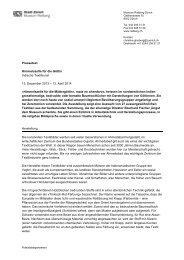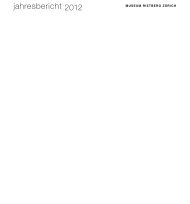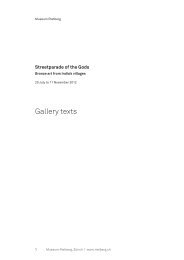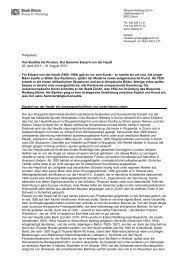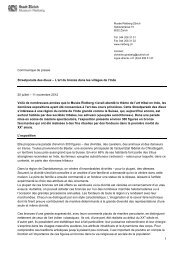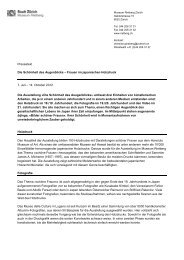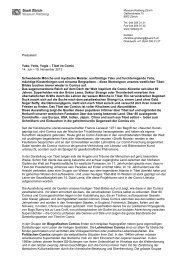1.1 eduard von der heydt - Museum Rietberg
1.1 eduard von der heydt - Museum Rietberg
1.1 eduard von der heydt - Museum Rietberg
You also want an ePaper? Increase the reach of your titles
YUMPU automatically turns print PDFs into web optimized ePapers that Google loves.
3.5<br />
erwerbungen<br />
bei <strong>der</strong> firma<br />
j.f.g. umlauff in<br />
hamburg<br />
J.F.G. Umlauff in Hamburg war zu Beginn des<br />
20. Jahrhun<strong>der</strong>ts einer <strong>der</strong> führenden Ethnographica-Händler<br />
in Deutschland. 1924 tätigte <strong>von</strong> <strong>der</strong> Heydt dort seinen<br />
ersten Einkauf, rund drei Dutzend Plastiken aus dem Kongo.<br />
1926 erwarb er über 1000 weitere Objekte: Ethnographica aus<br />
<strong>der</strong> Südsee – <strong>von</strong> <strong>der</strong> Heydts grösster En-bloc-Kauf. Kurz darauf<br />
verfasste <strong>der</strong> Kunsthistoriker Carl Einstein (1885–1940)<br />
einen Ausstellungskatalog. Der Kunsthändler Alfred Flecht-<br />
heim (1878–1937) stellte die wichtigsten Werke <strong>der</strong> Samm-<br />
lung in seiner Galerie in Berlin aus und vermittelte die Ausstellung<br />
ans Kunsthaus Zürich (1926). Ziel <strong>der</strong> Aktion war es,<br />
die Sammlung zu propagieren, um sie gewinnbringend weiterzuverkaufen.<br />
Das Vorhaben <strong>der</strong> Geschäftspartner scheiterte<br />
jedoch an mangelndem Interesse. Ein Teil <strong>der</strong> Südsee-<br />
Sammlung ging später in Paris verloren, die übrigen Werke<br />
befinden sich heute in Museen in Köln, Paris, St. Gallen und<br />
Zürich. Dieses Beispiel zeigt, dass <strong>von</strong> <strong>der</strong> Heydt nicht nur<br />
sammelte, son<strong>der</strong>n auch tauschte und verkaufte; Sammeln<br />
war für den Bankier ebenfalls Teil seiner Finanzgeschäfte.<br />
3.5<br />
acquisitions<br />
from the company<br />
j.f.g. umlauff<br />
in hamburg<br />
At the beginning of the 20 th century, J.F.G.<br />
Umlauff in Hamburg was one of the leading dealers in ethnographic<br />
art in Germany. Von <strong>der</strong> Heydt made his first acquisition<br />
there in 1924, some three dozen sculptures from the<br />
Congo. In 1926, he acquired more than a thousand further objects:<br />
ethnographic art from the South Seas – <strong>von</strong> <strong>der</strong> Heydt’s<br />
largest single purchase. Soon after this, the art historian<br />
Carl Einstein (1885–1940) wrote a catalogue for the collection.<br />
The art dealer Alfred Flechtheim (1878–1937) exhibited<br />
the most important works of the collection in his gallery in<br />
Berlin and passed on the exhibition to the Kunsthaus Zürich<br />
(1926). The aim of this was to draw attention to the collection<br />
with the intention of then selling it on for a profit. This failed,<br />
however, because of lack of interest. Parts of the South Seas<br />
collection were later lost in Paris; the remaining works are<br />
now in museums in Cologne, Paris, St. Gallen and Zurich. As<br />
this example shows, <strong>von</strong> <strong>der</strong> Heydt did not only collect art but<br />
also exchanged and sold it; for the banker, collecting was another<br />
part of his financial activity.<br />
3.5<br />
acquisitions<br />
auprès de la firme<br />
j.f.g. umlauff<br />
à hambourg<br />
Au début du XX e siècle, J.F.G. Umlauff était<br />
l’un des principaux marchands d’objets ethnographiques en<br />
Allemagne. C’est dans son magasin de Hambourg qu’en 1924,<br />
Eduard <strong>von</strong> <strong>der</strong> Heydt achète ses premières pièces, environ<br />
trois douzaines de sculptures du Congo. En 1926, il acquiert<br />
plus de 1000 nouveaux objets: de l’art ethnographique des<br />
mers du Sud – le plus vaste achat «en bloc» jamais effectué<br />
par le collectionneur. Peu après, l’historien de l’art Carl Einstein<br />
(1885–1940) rédige un catalogue d’exposition. Le marchand<br />
d’art Alfred Flechtheim (1878–1937) expose les principales<br />
œuvres de la collection dans sa galerie à Berlin et cette<br />
exposition sera présentée au Musée des beaux-arts de Zurich<br />
en 1926. Son objectif était de faire connaître la collection, afin<br />
de pouvoir la revendre avec un bénéfice. Le projet des partenaires<br />
commerciaux échoua toutefois, à cause du manque<br />
d’intérêt. Une partie de la collection d’art des mers du Sud<br />
disparaîtra plus tard à Paris; le reste des œuvres se trouve<br />
aujourd’hui dans des musées à Cologne, à Paris, à St-Gall et<br />
à Zurich. Cet exemple montre que le baron <strong>von</strong> <strong>der</strong> Heydt ne<br />
se contentait pas de collectionner, mais qu’il échangeait et<br />
revendait des œuvres d’art. Pour ce banquier, collectionner<br />
était aussi une activité financière.<br />
Die Ausstellung «Südsee-Plastiken» <strong>der</strong> Galerie Flechtheim, Berlin, im<br />
Kunsthaus Zürich (the exhibition “Südsee-Plastiken” by Galerie Flechtheim,<br />
Berlin, in the art museum of Zurich / l’exposition «Südsee-Plastiken»<br />
de la Galerie Flechtheim, Berlin, au musée d’art de Zurich), 1926<br />
(<strong>Museum</strong> <strong>Rietberg</strong> Zürich, Archiv)






